| |

Home
Thousands of tastings,
all the music,
all the rambligs
and all the fun
(hopefully!)



Whiskyfun.com
Guaranteed ad-free
copyright 2002-2024
|
 |
|
| Hi, this is one of our (almost) daily tastings. Santé! |
| |
|
| |
| |
October 1, 2024 |
|
  |
Two old independent Glenrothes
and a few aperitifs |
Honestly, you don’t really see many new official Glenrothes anymore, do you? Twenty years ago, they were quite prominent on Whiskyfun, and it’s true that we liked them a lot.
(The still house at Glenrothes in 2003, MM/WF Archive)
|
 |
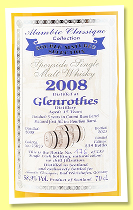
|
Glenrothes 15 yo 2008/2023 (58.9%, Alambic Classique, Caroni Rum barrel, cask #23023, 239 bottles) 
I must admit, the notion of giving a young Glenrothes a Caroni Rum barrel treatment strikes me as rather baffling, but it’s important to keep an open mind, isn’t it? Colour: gold. Nose: there's an odd mix of apple juice blended with petrol and olive oil, with a rubbery, almost sulphuric undertone in the background. Strange and certainly highly unusual. With water: think fireworks and spent matches, plus a whiff of new wellington boots. Mouth (neat): quite ‘trans’—almost peaty, fairly aggressive, salty, and oily, before it shifts towards a praline and orange note that’s unmistakably Glenrothes. With water: much improved, the sulphuric edge nearly vanishes, leaving behind raisins, orange chutney, bitter chocolate, and a touch of tobacco. Finish: long and very chocolaty (with water). Comments: this one demands a fair bit of patience—and understanding—from the taster. Essentially, it's best to jump straight to the palate after adding a splash of water. Quite the experiment!
SGP: 562 - 80 points. |
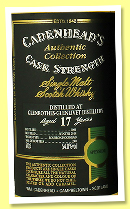
|
Glenrothes-Glenlivet 17 yo 2001/2018 (54%, Cadenhead, Authentic Collection, bourbon hogshead, 240 bottles) 
This one had been patiently waiting its turn. Colour: white wine. Nose: classic ‘Cadenhead’—pure barley eau-de-vie. Barley, fresh bread, chalk, flour, and green apples… With water: more of the same, but now with half a kiwi and a few greengages. Mouth (neat): sharp and bitter, but in a rather charming way. Lemon juice, grass, pears, apples, and gooseberries. The cask feels fully ‘refill’. With water: melon comes through, along with a slight salinity, almost like a crisp Atlantic coastal white wine. Finish: medium length, becoming earthier. Very ripe apples and, oddly enough, a tiny oyster (really?). Comments: the polar opposite of that ‘Caroni’, this one’s a pure barley lover’s dram.
SGP: 541 – 84 points. |
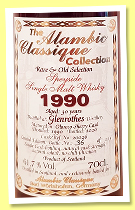
|
Glenrothes 30 yo 1990/2020 (61.7%, Alambic Classique, Rare & Old Selection, oloroso sherry cask, cask #20026, 113 bottles) 
This one feels like it’s going to be a classic old Glenrothes, reminiscent of those marvellous single casks the distillery was putting out some 20 years ago. Colour: dark mahogany. Nose: forty tonnes of chestnut cream and a box of Cuban cigars, with an earthy, basaltic backdrop, plus a natural sulphur note, like black truffle and soy sauce. Then comes artichoke liqueur, Cynar, a touch of wood glue, and very dark chocolate (we're talking over 90% cacao). With water: the truffle remains dominant, but now there are prunes and a hint of orange liqueur before the chocolate takes centre stage. Mouth (neat): much jammier than the nose suggests, with strawberry jam, crushed pepper, old armagnac, and a heap of cumin-spiced tobacco (if such a thing existed). With water: the artichoke returns, joined by aubergines, chocolate, tobacco, and prunes. You might even find a few morels. Finish: long, drier, with little shift in the flavour profile—bitter chocolate and truffles linger. Comments: a bit of a fighter, with a bone-dry oloroso character leading the charge. But that’s proper oloroso for us. I really like it, reminds me of some old Glen***clas.
SGP: 562 – 89 points. |
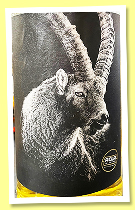
|
Glenrothes 36 yo 1986/2022 (45.6%, Acla da Fans, 10th Anniversary, hogshead, cask #2125) 
I've been eager to try this one for quite some time, and I must say, the label is one of the most beautiful in whisky since at least the 18th century. Truly. I'm sorry my lousy iPhone capture doesn't do it justice at all. Colour: pale gold. Nose: a hint of coconut at first, then it opens up like a fine white Burgundy Chardonnay, with buttery notes, ripe apples, toasted bread, and a mix of acacia honey, ripe mirabelles, and quince jelly. Honeysuckle and clover round off this rather lovely nose. Mouth: plenty of ripe apples and pears, white pepper, peach skins, and a touch of herbs—think sweet woodruff and mountain plants (you’ll be reminded of Swiss Ricola sweets, naturally). There's an elegant woodiness, leaning towards white tea with a faint trace of mango. Finish: nicely long, staying fresh with a bit of candle wax and a citrusy touch. A slight hint of sandalwood emerges as well. Comments: the beauty of a cask that wasn’t too active. Sure, it took 36 years, but without the magic of time, whisky is just the simplest, most rustic form of eau-de-vie, isn’t it?
SGP: 551 - 90 points. |
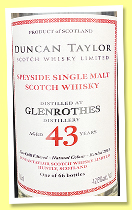
|
Glenrothes 43 yo (42.6%, Duncan Taylor, 66 bottles, 2013-2024) 
A rather special Glenrothes, either rebottled or relabelled for Edinburgh’s Whisky Fringe this year. I would guess, though I wouldn’t bet my life on it, that it’s a 1969 or 1970 vintage—those years are plentiful in Abe Rosenberg’s inventory, as far as I remember from leafing through it long ago. Colour: gold. Nose: the elegance of what we like to call a ‘beehivey’ whisky—meaning those with notes of old pinewood, pollen, honey, beeswax, nectar, and propolis, with very ripe apples in the mix. Ripe apple is one of the top aromas when it comes to whisky, and this one’s full of it. Mouth: immensely beautiful in its simplicity and modesty. Again, ripe apple, honey, old wood, and mead. It’s certainly not a showstopper, but just imagining that Hendrix and Joplin were likely still alive when this was distilled is enough to stir some emotion. Finish: not very long but wonderfully soft. Beeswax and floral nectar linger gently. Comments: perhaps a bit fragile by today’s standards, but honestly, who cares?
SGP: 541 - 90 points.
P.S. A charming little bird mentioned, after the tasting, that this might quite possibly stem from the Tantalus Collection. |
|
|
| |
|
|
|
|
|
|

